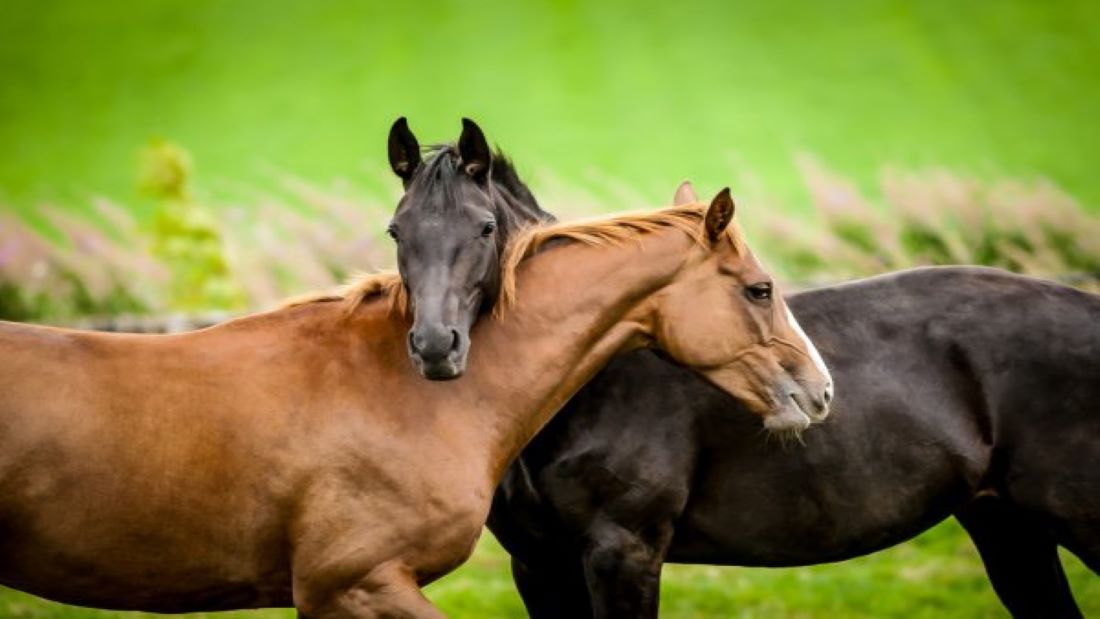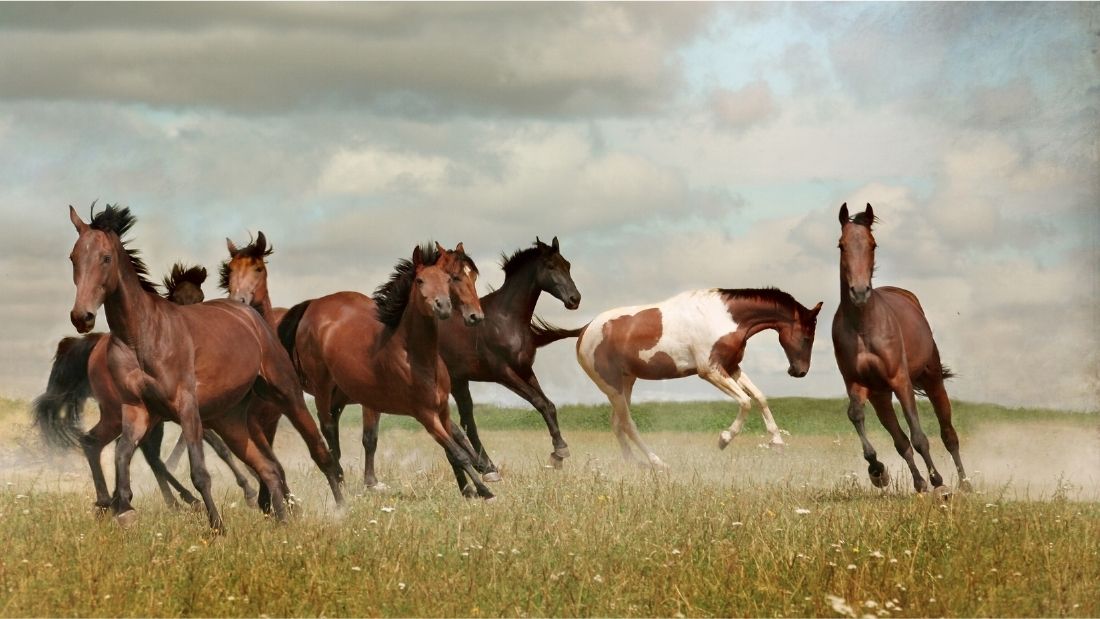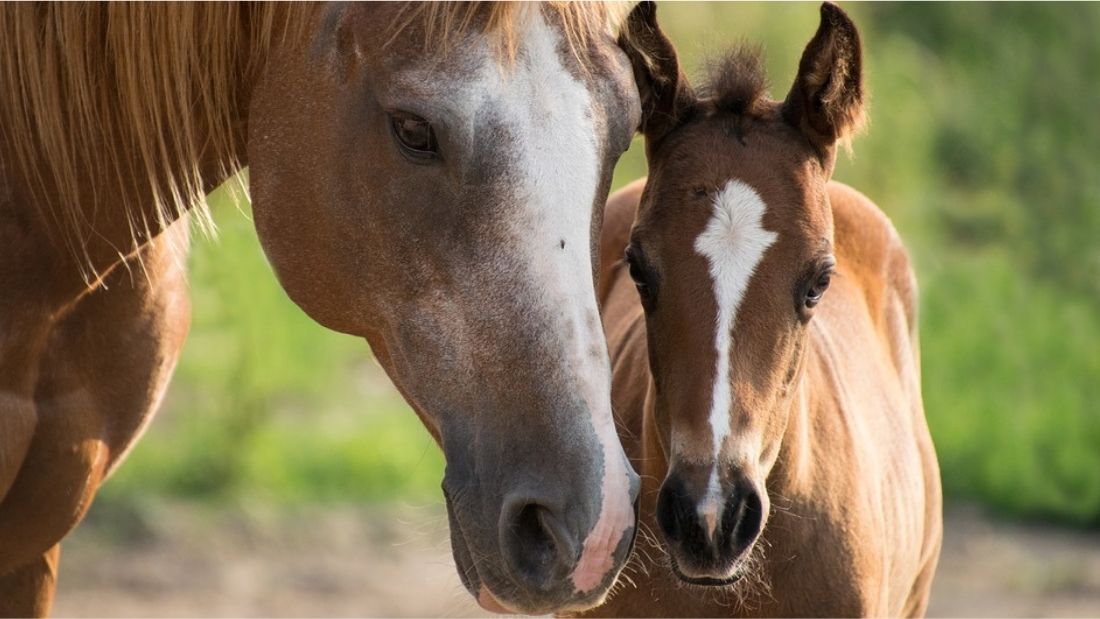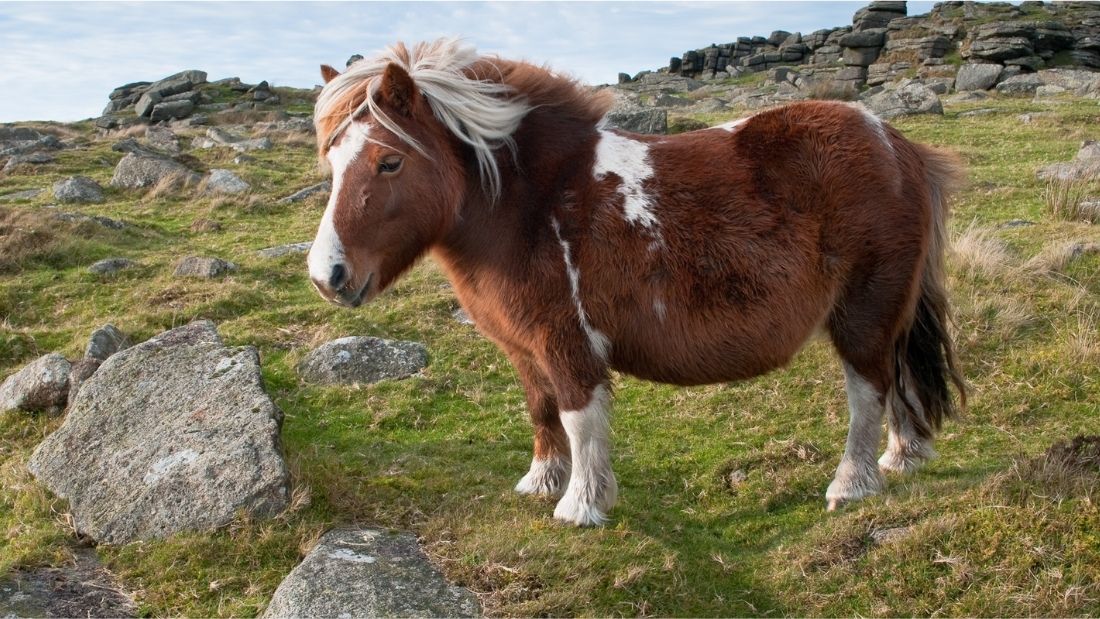How Horses Are Farmed and Killed

- Horses nap standing up. Thanks to a special locking system in their legs, they can take short naps upright, allowing them to flee quickly if a predator approaches1Tikkanen, A. 2020. Why do horses sleep standing up? Available at: https://www.britannica.com/story/why-do-horses-sleep-standing-up [Accessed 6th July 2020]
- Horses can read humans’ emotions and remember their moods — they learn your facial expressions and remember whether you’re generally a happy, grumpy or angry kind of a person.2McCrae, M. 2018. Not Only Can Horses Read Your Facial Expressions, They’ll Hold It Against You Later. Available at: https://www.sciencealert.com/horses-recognise-and-remember-emotional-human-facial-expressions [Accessed 6th July 2020]
- Newborn foals can stand within an hour of being born, enabling them to reach their mother’s teat for milk, and they can walk after just a couple of hours!3Horses.extension.org. 2020. Care of the newborn foal. Available at: https://horses.extension.org/care-of-the-newborn-foal/#:~:text=Usually%2C%20foals%20stand%20within%201,the%20foal%20stand%20by%20itself. [Accessed 6th July 2020]
- The eyes of a horse are bigger than those of any other land mammal. Located on the side of their heads, it means they can see almost 360 degrees— ideal for spotting predators approaching on open plains.4Hartley, C; Grundon, RA .2016. Chapter 5: Diseases and surgery of the globe and orbit.Equine Ophthalmology (3rd ed.).p. 151.
- Like elephants, horses never forget. They have excellent memories and can recall positive or negative experiences with others, including humans.5Sankey, C et al. 2010. Positive interactions lead to lasting positive memories in horses, Equus caballus. Animal Behaviour. v,79.P 869-875
- Horses can’t vomit. They have little-to-no gag reflex, and a very strong band of muscles around their oesophagus which acts as a one-way valve.6Bertone, J. 2015. Equusmagazine.com.2020. Q&A: Why can’t horses vomit? Available at: https://equusmagazine.com/horse-care/qa-horses-vomit-28006

Horses are incredibly sociable creatures and their herd mentality is one of the reasons why they have survived and thrived all over the world for thousands of years.
Wild horses live in small matriarchal groups of three to 10 individuals. Although hierarchical, there is a constant struggle for power.
One of the ways horses exert dominance over another horse in the group is to make them move when they don’t want to – and that’s why you see them jostling for space. It’s a constant power struggle with high stakes — higher-ranked animals eat and drink first and if there’s limited food, lower ranked horses may not eat at all.1Williams, A. 2004. The Basics of Equine Behavior. Available at: https://esc.rutgers.edu/fact_sheet/the-basics-of-equine-behavior/ These hierarchies and power balances are always evolving and there isn’t necessarily one horse who’s the constant leader.2Lesté-Lasserre, MA. 2016. Article, Behavior, Behavior & Handling, Horse Care, Horsemanship Science. Available at: https://thehorse.com/111721/understanding-herd-dynamics/
Horses communicate with each other in a variety of subtle ways. A movement as small as the flick of an ear, or a tail, can send a signal to the entire herd. They can use vocal sounds such as snorts, whinnies, and nickers, as well as using their hooves to paw and stomp. If a horse is scared, angry or trying to warn another horse off, it shows with squeals, bite threats, pinned ears or rolling eyes. Communication through smell comes into play too — horses will smell each other’s droppings and each other’s breath when forming relationships.2Lesté-Lasserre, MA. 2016. Article, Behavior, Behavior & Handling, Horse Care, Horsemanship Science. Available at: https://thehorse.com/111721/understanding-herd-dynamics/
Horses form strong bonds within their group, both with family members and other, non-related horses. They often have a ‘best friend’ who they spend more time with and take naps with. It isn’t clear why certain horses bond together but like humans, they have individual personalities, and their relationships change over time — friendships come and go, foals grow up and leave the herd and stallions move on to new mares.
The bonds that horses form with one another are so important that separating a domestic horse from their friend in the field can cause them severe anxiety.3McAllister, R. 2008. The Heartbreak of Separation Anxiety. Available at: https://thehorse.com/124719/the-heartbreak-of-separation-anxiety/ It’s rooted in the fact that, in the wild, these social attachments are a matter of life and death — alliances and their identity in the herd afford protection from predators.4Williams, W. 2017. The Secret Lives of Horses. Available at: https://www.scientificamerican.com/article/the-secret-lives-of-horses1/

The horse (Equus ferus caballus) is an odd-toed ungulate mammal belonging to the taxonomic family Equidae. They have evolved over the past 50 million years from a small multi-toed creature into today’s large, single-toed animals.1Grubb, P. (2005). “Order Perissodactyla”. In Wilson, D.E.; Reeder, D.M (eds.). Mammal Species of the World: A Taxonomic and Geographic Reference (3rd ed.). Johns Hopkins University Press. pp. 630–631. ISBN 978-0-8018-8221-0.
Domestication of horses began around 6,000 years ago in the western part of the Eurasian Steppe — Ukraine, southwest Russia and west Kazakhstan. They were domesticated to be used for their milk and meat and also transport.2Briggs, H. 2012. Mystery of horse taming ‘solved’ by gene study. Available at: https://www.bbc.co.uk/news/science-environment-17943974#:~:text=Horses%20were%20domesticated%206%2C000%20years,in%20the%20journal%20PNAS%20suggests.
Today there are more than 400 breeds of horses spread across every continent, except Antarctica.3Bradford, A. 2015. Horse Facts. Available at: https://www.livescience.com/50714-horse-facts.html#:~:text=Horses%20are%20very%20social%20animals,of%20females%20and%20their%20young.
In the wild
The only truly wild horse left in existence is the Przewalski’s horse, which once roamed from Manchuria to Spain. They are now critically endangered with only a few thousand left in the wild3Bradford, A. 2015. Horse Facts. Available at: https://www.livescience.com/50714-horse-facts.html#:~:text=Horses%20are%20very%20social%20animals,of%20females%20and%20their%20young. Other breeds that live wild, such as Dartmoor ponies and Mustangs, are designated as ‘feral’ because they’re not truly wild, but descended from domesticated horses.
Naturally, horses live in small groups of three to 10 individuals roaming over large distances. Closely allied mares and their foals form the core of the band, protected by one stallion.4Williams, A. 2004. The Basics of Equine Behavior. Available at: https://esc.rutgers.edu/fact_sheet/the-basics-of-equine-behavior/ Young stallions live in a bachelor herd until they find their own herd of females.

Mares generally give birth to just one foal and twins are rare. Her gestation lasts around 11 months and when born, the foal is able to stand, walk and even run within a couple of hours. It’s so that the foal can immediately keep moving with the herd and stay out of danger.
At around two years old, the young male (colt), is driven away from the herd by a stallion and will join other young males until he finds his own herd to lead.3Bradford, A. 2015. Horse Facts. Available at: https://www.livescience.com/50714-horse-facts.html#:~:text=Horses%20are%20very%20social%20animals,of%20females%20and%20their%20young.
A horse’s diet
Horses are herbivores and eat vegetation such as grass, herbs, leaves and fruits, such as acorns, but they need to eat a lot; up to two per cent of their body weight in roughage every day. With just one small stomach, they have to graze all day to get the nutrients they need.3Bradford, A. 2015. Horse Facts. Available at: https://www.livescience.com/50714-horse-facts.html#:~:text=Horses%20are%20very%20social%20animals,of%20females%20and%20their%20young.
How long do horses live?
The natural lifespan of a domesticated horse is 25-30 years but the oldest verifiable horse lived to the age of 62.5Ensminger, M. E. 1990. Horses and Horsemanship: Animal Agricultural Series (Sixth ed.). Interstate Publishers.

Although not popular in the UK, horse meat is still commonly eaten in many countries around the world and globally, around 4.7 million horses are eaten every year.1Lorenzo JM et al. 2019. More than Beef, Pork and Chicken – The Production, Processing, and Quality Traits of Other Sources of Meat for Human Diet. Springer. P.34
In Europe, tens of thousands of horses are subjected to the horrors of live transport, sometimes travelling for days across borders in cramped conditions —a horrifying ordeal for these highly sensitive and social animals.
Poland has historically been one of the biggest exporters of horses for meat, with more than 10,000 horses being exported in 2019 alone.2Statista. 2020. Value of live horses, asses, mules and hinnies exported from Poland from 2012 to 2019. Available at: https://www.statista.com/statistics/770053/live-horses-asses-mules-hinnies-export-value-poland/ The majority are destined to be slaughtered in Italy which has a strong market for horse meat. France and Belgium also import horses for slaughter.3Hsi.org. 2014. Long-distance horse transports in the European Union. Available at: https://www.hsi.org/wp-content/uploads/assets/pdfs/horses_EU_long-distance_horse_transports_in_EU.pdf
In 2002 Viva! carried out an undercover investigation into horses live exported from Poland. We revealed the traumatic journeys they had to endure, including emaciated horses, horses with broken legs and horses being beaten by handlers.
As a result of our campaigning against this cruel trade, the numbers of horses exported from Poland went from 100,000 a year in 2002 to 30,000 a year in 2005.4Bonomini, 2005. Ordeal of horses off to slaughter. Available at: https://www.worcesternews.co.uk/news/7451942.ordeal-of-horses-off-to-slaughter/
Are horses eaten in the UK?
Horse meat is not illegal in the UK but is rarely consumed. It was eaten here until the 1930s but grew increasingly unpopular as British people started to see horses more as companion animals.5Itv.com. 2013. How ‘healthy’ horsemeat fell out of favour in the UK. Available at: https://www.itv.com/news/2013-02-14/how-healthy-horsemeat-fell-out-of-flavour-in-the-uk/
Despite not often being eaten here, they are still slaughtered in the UK. The resulting horse meat is exported and eaten in other European countries, such as Belgium and France.6Defra. 2019. Results of the 2018 FSA Survey into Slaughter Methods in England and Wales. Available at: https://assets.publishing.service.gov.uk/government/uploads/system/uploads/attachment_data/file/778588/slaughter-method-survey-2018.pdf [Accessed 6 July 2020]
Although it is commonly thought that horse meat ends up in dog food, this is not the case. In the past horse meat was used in pet food in the UK and the US, but this is no longer permitted.
How many horses are slaughtered in the UK?
The statistics on horse slaughter are not freely available in the same way that statistics on other farmed animals are.
Via a Freedom of Information (FOI) request, Viva! discovered that in 2019, in England, Northern Ireland and Wales, a total of 2,165 animals – horses, donkeys and mules – were slaughtered for human consumption (the soliped/equidea category).7Food Standards Association. 2020. Response to Viva! Freedom of Information Request on 7 July 2020 FOI 2594
Past FOI requests have shown that the number of horses slaughtered in the UK has decreased dramatically — 8,500 in 2012, dropping to 4,500 in 2014.8FSA catalogue. 2015. foi-response-horses-slaughtered-food-chain.https://fsa-catalogue2.s3.eu-west-2.amazonaws.com/foi-response-horses-slaughtered-food-chain.pdf
Over the past decade, injured thoroughbreds and those who don’t meet racing standards, have been sold to slaughterhouses and their meat exported.9Animalaid.org.uk. 2020. Bred to Death. Available at: https://www.animalaid.org.uk/the-issues/our-campaigns/horse-racing/bred-to-death/ [Accessed 6 July 2020] An investigation in 2011 revealed that 1,100 racehorses were slaughtered in UK abattoirs.10Milmo, C. 2013. 1,000 racehorses a year in UK abattoirs. Shocking failures in checks. How do we know thoroughbreds aren’t in our food? Available at: https://www.independent.co.uk/news/uk/home-news/1000-racehorses-a-year-in-uk-abattoirs-shocking-failures-in-checks-how-do-we-know-thoroughbreds-8496027.html
Although no official records are kept as to the breeds of horses killed in UK slaughterhouses, investigations have reported them to be made up of injured and surplus horses from the racing industry as well as other sport horses and ex riding school ponies.11Animalaid.org.uk. 2007. Horse slaughter in an English abattoir. Available at: https://www.animalaid.org.uk/horse-slaughter-english-abattoir/[Accessed 6 July 2020]
Dartmoor ponies
Tragically, hundreds of Dartmoor ponies are culled each year because nobody wants them. These native wild ponies have lived on Dartmoor in Devon since the Bronze Age and are now owned by local farmers.

Although they are allowed to roam the moors for most of the year, they are rounded up again over the winter and returned to the farmers. Many of the male foals will be taken to markets to be sold to prevent aggression and fighting with the stallions. Old horses will also be sold when they become too old to roam.
Some become riding school ponies and those that are left unsold are unable to be returned to the moors due to regulations. The remaining ponies are therefore shot and sometimes their meat is sold to zoos for their big cats, or even as pony meat for local Devon farmers markets.12Utton, D. 2017. Hungry enough to eat a horse? Dartmoor ponies are to be slaughtered for their meat. Available at: https://www.express.co.uk/news/nature/856402/Dartmoor-ponies-horse-meat-food-slaughter13Beard, M. 2002. Cull awaits the Dartmoor ponies that no one wants. Available at: https://www.independent.co.uk/environment/cull-awaits-the-dartmoor-ponies-that-no-one-wants-5360051.html
The horse meat scandal
In 2013, the European horse meat scandal broke when it was discovered many foods advertised as containing beef were found to contain horse meat – not declared on the label, of course — amounting to 100 per cent of the meat content in some cases.14BBC.co.uk. 2013. Findus beef lasagne contained up to 100% horsemeat, FSA says. Available at: https://www.bbc.co.uk/news/uk-21375594
Investigations unearthed a complex web of fraud throughout Europe which even led back to drug and horse smuggling, animal welfare abuses and implicated one of Europe’s richest beef tycoons. It raised all kinds of questions in Britain about where meat was coming from and put pressure on supermarkets to make their supply chains more transparent.15Lawrence, F. 2013. Horsemeat scandal: where did the 29% horse in your Tesco burger come from? Available at: https://www.theguardian.com/uk-news/2013/oct/22/horsemeat-scandal-guardian-investigation-public-secrecy
For most British people, eating horses is a taboo and they were disgusted, but it also raised concerns about not knowing about the health risks of horse meat. This was due to a drug called Phenylbutazone, or ‘Bute’, which is given to horses for pain relief. If ingested by humans there is a small risk that it can trigger a serious blood disorder which can prove fatal if left untreated.16McKie, R. 2013. Horsemeat does carry a health risk, but it’s incredibly small. Available at: https://www.theguardian.com/world/2013/feb/09/horsemeat-in-ready-meals-health-risk#:~:text=The%20problem%20is%20that%20bute,disorder%20known%20as%20aplastic%20anaemia.
According to a 2018 Defra report, there is just one slaughterhouse for the thousands of horses killed for meat in the UK. The majority come from dealers who buy up the leftover horses and ponies at horse and livestock markets.1Defra. 2019. Results of the 2018 FSA Survey into Slaughter Methods in England and Wales. Available at: https://assets.publishing.service.gov.uk/government/uploads/system/uploads/attachment_data/file/778588/slaughter-method-survey-2018.pdf [Accessed 6 July 2020]
Due to horses’ high sensitivity, social nature and flightiness, there are special procedures for slaughtering them in the UK. They are not supposed to be killed within sight of any other horse or in a room that contains the remains of horses or other animals. This whole process is to avoid triggering a natural fear response to their impending death.2Gov.uk.2019. Red meat slaughterhouses: restraining, stunning, killing animals. Available at: https://www.gov.uk/guidance/red-meat-slaughterhouses-restraining-stunning-killing-animals#killing-horses
The standard practice in the UK for killing horses is a free bullet (as opposed to a captive bolt), fired from a rifle at point-blank range into the brain. Just like other livestock killed to be eaten, their bodies are then shackled by the hind legs, they are hauled up onto a production line by their shackled legs and their throats are cut. Their blood is drained out before they go through the meat processing procedure.3Rawstorne, T. 2008. How 5,000 horses a year secretly go to slaughter. Available at: https://www.dailymail.co.uk/news/article-507214/How-5-000-horses-year-secretly-slaughter.html
Since horse meat is not popularly consumed in the UK, 94 per cent of it is exported with just six per cent remaining in the UK — sold to meat markets, butchers and individual customers.1Defra. 2019. Results of the 2018 FSA Survey into Slaughter Methods in England and Wales. Available at: https://assets.publishing.service.gov.uk/government/uploads/system/uploads/attachment_data/file/778588/slaughter-method-survey-2018.pdf [Accessed 6 July 2020]
Horses are sensitive, emotional and highly social animals that have roamed the earth for thousands of years. Yet, around the world, horses are used for food, transport and entertainment and kept in a way that robs them of their natural behaviours.
Although not on the same scale as other livestock farming, thousands of horses a year are still slaughtered and exported for their meat. A large proportion of these horses have been used up and spat out by sports and entertainment organisations.
The only way you can ensure that you are not contributing to industries that put profit over animal welfare, is to go vegan.





